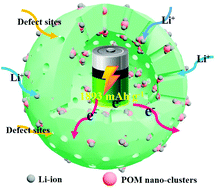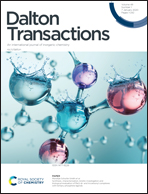Insights into the lithium diffusion process in a defect-containing porous crystalline POM@MOF anode material†
Abstract
Rechargeable lithium-ion batteries (LIBs) for potentially low-cost and high-energy-density storage have been intensively researched to meet ever-growing demands. Achieving higher storages and understanding the transporting and storing diffusion process of Li ions are still great challenges. Herein, a porous crystalline polyoxometalate-based metal–organic framework (POM@MOF), H2[CuII4(Htrz)5(H2O)2][MoVI4CuII4O26]0.5·3H2O, with defect sites as a LIB electrode material is reported. The Li-ion diffusion process in the material was investigated using ex situ X-ray photoelectron spectroscopy (XPS) and off-line powder X-ray diffraction (PXRD), indicating that O atoms of POM nano-clusters can be regarded as Li-ion acceptors (storage sites); meanwhile the defect sites (uncoordinated N atoms or –N–H groups) in the crystalline material also participate in the Li-ion storage. The reported porous crystalline POM@MOF material with defects delivers a remarkable Li-ion storage capacity of ca. 700 mA h g−1 in 200 cycles at a current density of 100 mA g−1.



 Please wait while we load your content...
Please wait while we load your content...